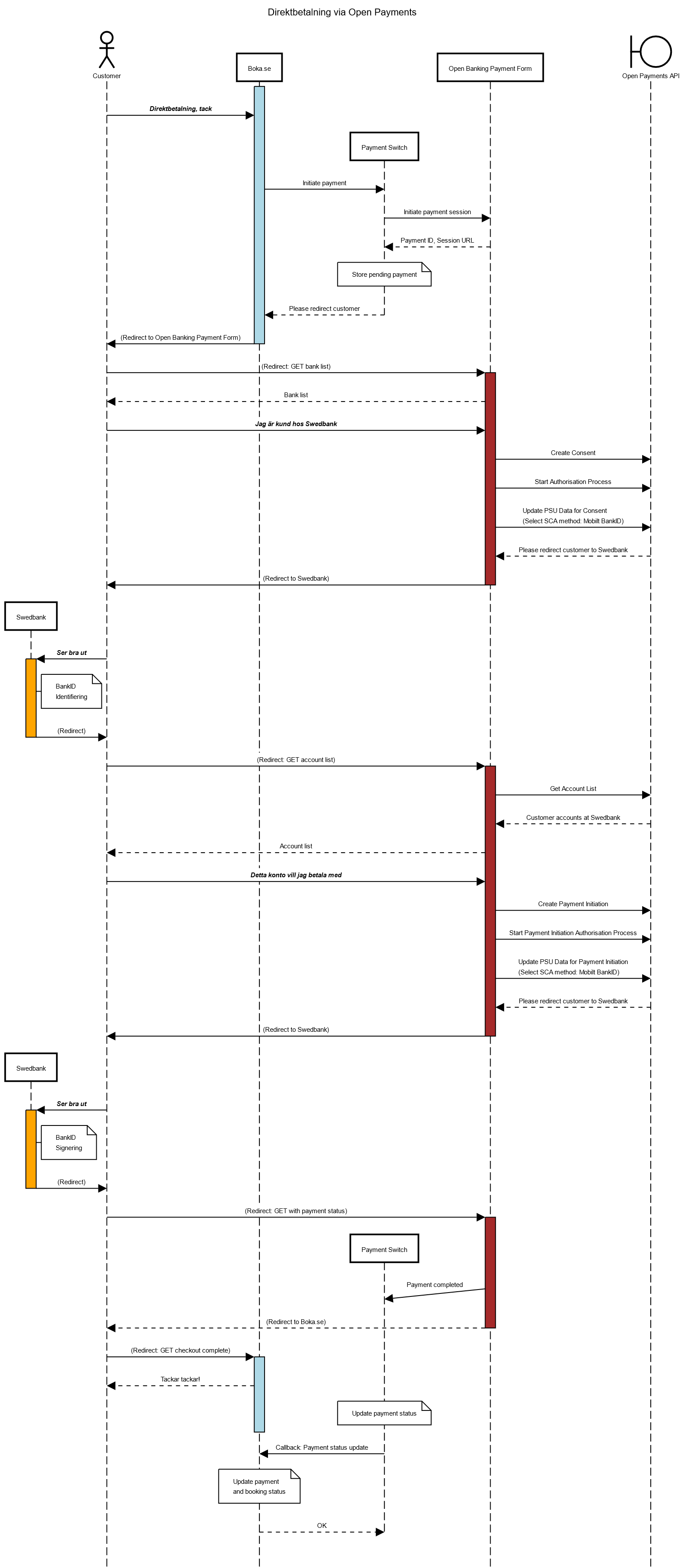The Ping Payments™ integration with Open Payments offers payments via payment initiation service.

Using the Open Payments PIS Flow
This describes a typical happy path case.
Let's assume we run frontend and backend services that have an integration with the Ping Payments API. We provide several possible payment methods through Ping Payments, but the customer who is about to make a purchase wants to make an open banking payment through Open Payments payment initiation service (PIS).
Making a Purchase
Our customer or payer makes the purchase, and gets to the payment options.
Payer
- Chooses the Open Payment PIS option
- Clicks pay in the user interface
It's our backend's turn.
First, it's time for a payment order .
Backend
- Creates a new payment order
- Posts the new payment order to the Ping Payments API
Notes:
- The header of the request we send to the Ping payments API contains our tenant_id
- The body of the request we send to the Ping payments API contains a currency.
Create a payment order with the Payment Order endpoint.
The Ping Payments API starts working on our payment order,
Ping Payments API
- Receives the request from our backend
- Saves the payment order
- Sends a response to back to our backend
Note:
- A successful response from the Ping Payments API contains the payment_order_id of the new payment order.
Ping Payments recommends that you persist payment_order_ids in your backend
Now, it's time for the Payment object.
Backend
- Receives the response from the Ping Payments API and saves the payment_order_id
- Creates a new payment
- Posts the new payment to the Ping Payments API
Notes:
- Set open_payments as the payment provider property and pis as the payment method property
- Always include the payment_order_id of the new payment
Create a payment with the Payments endpoint.
Ping Payments recommends that you Include a valid status_callback_url in the paymentYour backend won't receive status updates on payments without a working status_callback_url.
Our part is done for now, and it's time for the Ping Payments API to get to work.
Making the Payment
Ping Payments API needs to send the Payment on to Open Payments.
Ping Payments API
- Receives request from backend
- Creates a payment request in the correct format for PIS
- Posts the payment request to Open Payments
Note: Any future updates to this payment will be sent as webhooks to the provided status_callback_url
It's time for Open Payments to do their part.
Open Payments PIS
- Receives request
- Saves and readies the payment for processing
- Returns a checkout URL
Now that the Ping Payments API has passed us the URL, it's time for our backend to take responsibility of the payment again.
Backend
- Receives response from the Ping payments API
- Saves and updates information as needed in our database
- Passes our payment status and checkout URL to frontend
Since our payer needs to know where and how to pay, our frontend has a little bit work left to do.
Frontend
- Receives checkout URL from backend
- Prompt a redirect to the Open Banking checkout via URL in the payer's client
Note: Iframing the checkout is possible
Checkout
- Payer will select their bank
- Bank ID verification will start. If payer is on mobile, the Bank ID app will start automatically, otherwise a qr-code will display.
- Payer chooses which account to use in this payment and pays.
Finishing the Payment
Since the payer paid through the Open Payments page, they have the necessary information to finalize the Payment.
Open Payments
- Finishes off the Payment
- Sends updated payment status to the Ping Payments API
The Ping Payments API is about to receive the updated payment status.
Ping Payments API
- Receives updated payment status
- Updates and saves payment status of payment and payment order
- Sends updated payment status to our backend via the status_callback_url
Once our backend receives the new payment status from the Ping Payments API, we too can finish off this purchase.
Backend
- Receives updated payment status
- Saves updated payment status
- Performs any actions we've decided on, such as updates to frontend for our pay to see or sends an email with a receipt
PayerSees and reviews any information received from us, and is done with the purchase
Cancellation
In case the payer cancels the payment or if the payment fails for any reason there is a cancel_url and an error_url to be set in the payment initiation step.